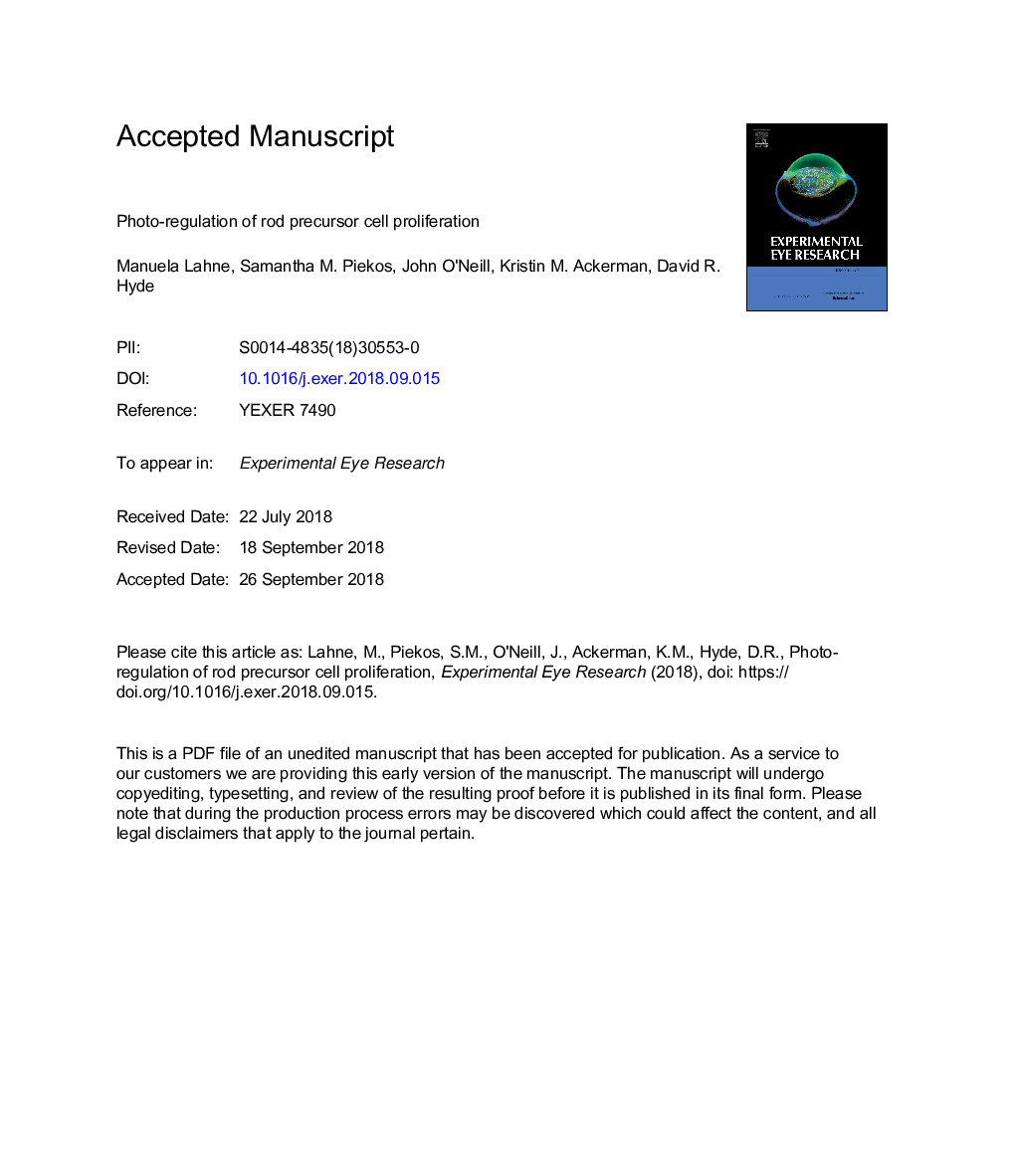| کد مقاله | کد نشریه | سال انتشار | مقاله انگلیسی | نسخه تمام متن |
|---|---|---|---|---|
| 11025408 | 1697210 | 2019 | 38 صفحه PDF | دانلود رایگان |
عنوان انگلیسی مقاله ISI
Photo-regulation of rod precursor cell proliferation
دانلود مقاله + سفارش ترجمه
دانلود مقاله ISI انگلیسی
رایگان برای ایرانیان
کلمات کلیدی
PBSCMZciliary marginal zoneNPCPCNAONL(E)GFPINLGCLSLCDAPINeuronal progenitor cell(enhanced) green fluorescent protein - (افزایش یافته) پروتئین فلورسنت سبز4′,6-diamidino-2-phenylindol - 4 '، 6-دیامیدینو-2-فینیلندول5-ethynyl-2′-deoxyuridine - 5-ethynyl-2'-deoxyuridineDMSO - DMSOEdU - EDUIgf1 - IGF1Proliferating Cell Nuclear Antigen - آنتیژن هسته ای تکثیر سلولیTerminal deoxynucleotidyl transferase dUTP nick end labeling - ترمینال deoxynucleotidyl transferase dUTP نام نهایی پایان نامهTUNEL - تونلDimethyl sulfoxide - دیمتیل سولفواکسیدDark adaptation - سازگاری تیرهRetina - شبکیهinsulin-like growth factor 1 - فاکتور رشد مانند انسولین 1Rod photoreceptor - فتورسپتور رادPhosphate buffered saline - فسفات بافر شورouter nuclear layer - لایه بیرونی هسته ایinner nuclear layer - لایه داخلی هسته ایganglion cell layer - لایه سلول گانگلیونیadult neurogenesis - نوروژنز بزرگسالانZebrafish - گورخرماهی
موضوعات مرتبط
علوم زیستی و بیوفناوری
ایمنی شناسی و میکروب شناسی
ایمونولوژی و میکروب شناسی (عمومی)
پیش نمایش صفحه اول مقاله

چکیده انگلیسی
Teleosts are unique in their ability to undergo persistent neurogenesis and to regenerate damaged and lost retinal neurons in adults. This contrasts with the human retina, which is incapable of replacing lost retinal neurons causing vision loss/blindness in the affected individuals. Two cell populations within the adult teleost retina generate new retinal neurons throughout life. Stem cells within the ciliary marginal zone give rise to all retinal cell types except for rod photoreceptors, which are produced by the resident Müller glia that are located within the inner nuclear layer of the entire retina. Understanding the mechanisms that regulate the generation of photoreceptors in the adult teleost retina may ultimately aid developing strategies to overcome vision loss in diseases such as retinitis pigmentosa. Here, we investigated whether photic deprivation alters the proliferative capacity of rod precursor cells, which are generated from Müller glia. In dark-adapted retinas, rod precursor cell proliferation increased, while the number of proliferating Müller glia and their derived olig2:EGFP-positive neuronal progenitor cells was not significantly changed. Cell death of rod photoreceptors was excluded as the inducer of rod precursor cell proliferation, as the number of TUNEL-positive cells and l-plastin-positive microglia in both the outer (ONL) and inner nuclear layer (INL) remained at a similar level throughout the dark-adaptation timecourse. Rod precursor cell proliferation in response to dark-adaptation was characterized by an increased number of EdU-positive cells, i.e. cells that were undergoing DNA replication. These proliferating rod precursor cells in dark-adapted zebrafish differentiated into rod photoreceptors at a comparable percentage and in a similar time frame as those maintained under standard light conditions suggesting that the cell cycle did not stall in dark-adapted retinas. Inhibition of IGF1-receptor signaling reduced the dark-adaptation-mediated proliferation response; however, caloric restriction which has been suggested to be integrated by the IGF1/growth hormone signaling axis did not influence rod precursor cell proliferation in dark-adapted retinas, as similar numbers were observed in starved and normal fed zebrafish. In summary, photic deprivation induces cell cycle entry of rod precursor cells via IGF1-receptor signaling independent of Müller glia proliferation.
ناشر
Database: Elsevier - ScienceDirect (ساینس دایرکت)
Journal: Experimental Eye Research - Volume 178, January 2019, Pages 148-159
Journal: Experimental Eye Research - Volume 178, January 2019, Pages 148-159
نویسندگان
Manuela Lahne, Samantha M. Piekos, John O'Neill, Kristin M. Ackerman, David R. Hyde,